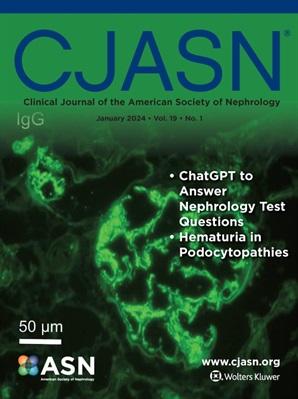预测急性肾损伤幸存者肾脏疾病进展的生物标志物组
IF 8.5
1区 医学
Q1 UROLOGY & NEPHROLOGY
Clinical Journal of the American Society of Nephrology
Pub Date : 2025-03-01
Epub Date: 2024-12-13
DOI:10.2215/CJN.0000000622
引用次数: 0
摘要
背景:急性肾损伤(AKI)会增加慢性肾脏疾病(CKD)的风险。我们的目的是找出能预测 AKI 后长期肾病风险的临床变量和生物标志物组合:我们分析了 "AKI 的评估、序列评价和后续后果(ASSESS-AKI)研究 "中 723 名 AKI 住院患者的前瞻性队列数据。我们利用机器学习研究了 75 个候选预测因子,包括出院后三个月随访时测量的生物标志物,以预测三年内的主要不良肾脏事件(MAKE),即 eGFR 下降≥40%、发展为终末期肾病(ESKD)或死亡:研究参与者的平均年龄为 64 ± 13 岁,68% 为男性,79% 为白种人。214名患者(28%)在3年的随访中发展为MAKE。使用所有 75 个预测因子的随机森林和 LASSO 惩罚回归模型得出的接受者工作特征曲线下面积 (AUC) 值分别为 0.80(95% CI:0.69-0.91)和 0.79(95% CI:0.68-0.90)。白蛋白尿、可溶性肿瘤坏死因子受体 1 (sTNFR1) 和使用利尿剂是最一致的预测因子。使用前 8 个预测变量的简化模型显示,MAKE 的分辨力同样很强(AUC = 0.78;95% CI:0.66-0.90)。临床影响效用分析表明,八项预测变量模型可将 AKI 后护理效率提高 55%(筛查/随访 MAKE 事件所需次数从 3.55 降至 1.97)。对于肾脏特异性结果 eGFR 下降或 ESKD,四预测模型显示出很强的区分度(AUC = 0.82;95% CI:0.68-0.96):结论:结合临床数据和生物标志物可以准确识别高危 AKI 患者,从而实现个性化的 AKI 后护理并改善预后。本文章由计算机程序翻译,如有差异,请以英文原文为准。
Biomarker Panels for Predicting Progression of Kidney Disease in Acute Kidney Injury Survivors.
求助全文
通过发布文献求助,成功后即可免费获取论文全文。
去求助
来源期刊
CiteScore
12.20
自引率
3.10%
发文量
514
审稿时长
3-6 weeks
期刊介绍:
The Clinical Journal of the American Society of Nephrology strives to establish itself as the foremost authority in communicating and influencing advances in clinical nephrology by (1) swiftly and effectively disseminating pivotal developments in clinical and translational research in nephrology, encompassing innovations in research methods and care delivery; (2) providing context for these advances in relation to future research directions and patient care; and (3) becoming a key voice on issues with potential implications for the clinical practice of nephrology, particularly within the United States. Original manuscript topics cover a range of areas, including Acid/Base and Electrolyte Disorders, Acute Kidney Injury and ICU Nephrology, Chronic Kidney Disease, Clinical Nephrology, Cystic Kidney Disease, Diabetes and the Kidney, Genetics, Geriatric and Palliative Nephrology, Glomerular and Tubulointerstitial Diseases, Hypertension, Maintenance Dialysis, Mineral Metabolism, Nephrolithiasis, and Transplantation.

 求助内容:
求助内容: 应助结果提醒方式:
应助结果提醒方式:


